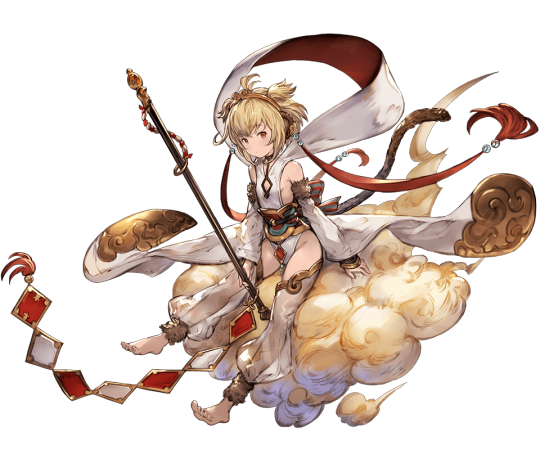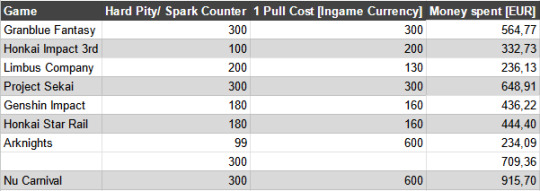Don't wanna be here? Send us removal request.
Text
My musing about inaccessibility for new players of long running gachas
The most vivid memory a gacha game left me with was playing Granblue Fantasy (GBF). It was a mixed bag for me on the one hand enjoying their heartfelt story and their bright cast of characters while on the other hand being a beginner frustated with their longwinded and confusing navigation as well as tutorial hell.
Before I started playing GBF I already had experience with other gacha, mostly Ayakashi: Ghost Guild. Even then, nothing would've prepared me for GBF.
Personally, I would dub it the most beginner unfriendly game I have ever experienced. When I started out it was around 2018 when the anniversary event "What makes the sky blue: Paradise Lost" was released.
I became interested in the game when on twitter someone posted about a character named Belial, the antagonist of the anni event. He caught the attention of many players because he talks with a raunchy and suggestive undertone.
youtube
Funnily enough, Belial being a slut was the only reason I wanted to start playing GBF but I digress.
In the beginning I just played the event and afterwards progressed by just reading the main story. The more time went on, the more I came across information and options.
Stuff like: Recruiting Eternals, Seraphic Weapons, Fate Episode, Coop, Bahamut Weapons, Class, Class Weapons, Weapon Grid, Xeno Weapons, Rank Uncap, etc.
First of all, finding those things within the game was and is sometimes still a challenge for me. More then often certain options are buried in multiple conveluted subpages.

Another thing is the information overload you get when looking up for certain things. For example you want to know what a grid is and ultimately build it. Case in point:

Okay, it might be unfair to say that this page is too much information if you only want to look at a specific element.
Still, as a beginner you have to still look up all the required weapons: where to grind them, how many, what does it do, do i need it, what weapon can i substitute it with and so on and forth. It is still mentally taxing.
And in the end, if you look at an incredibly long wiki page, at least for me, I automatically lose all motivation to go on.
Luckily enough I could ask a friend for advice but it makes me wonder do i really want to rely on other people to teach me how to play a game?
I can imagine that this is a ongoing problem because the older a gacha game becomes the more content it will get therefore making it harder for newcomer to hop right on.
In the end I pushed through by on playing content I only cared about and with a lot of help from a friend but to this day, I still feel like I haven't unlocked the full potential. The most important part is that I can comfortably clear most content and that's enough for me.
0 notes
Text
Rate-up is a lie
is a popular phrase within the gacha community. Players use it to mock their failed attempts to get their desired character from the gacha pool, blaming it on the shining lettering on the banner, "rate-up".
Of course, we all know that what we play is dependent on RNG. That's why we say it jokingly. But imagine if rate-ups were a lie?
It is a preposterous thought, and people would definitely be outraged, but what if I were to tell you that it did happen? Veterans are very much familiar with this case I’m about to talk about.
The game was alleged to deceive its player base and subsequently changed the industry forever. The game in question is Granblue Fantasy by Cygames.
It is the year 2016. Cygames’ second consecutive year on the market and New Year is around the corner, so why not celebrate by introducing a new limited character for players to pull.

Amidst all those players, there is a livestreamer, Taste, who shared his attempts. However, his efforts were in vain and went viral after he obtained Andira after 2,276 pulls (5358,50€ in monetary value [exchange rate as of 31.12.2015). [1]
More reports of other players were coming in, confirming that they needed to spend a high number of pulls to get her. As time passed, it became clear that something was fishy.
Remember the saying from the beginning – rate-up is a lie? Well, someone put in the effort to collect data and put it into numbers. [2] Suddenly, it dawned on the community. The rate-up was… not a lie! Instead, it was misleading.
Andira, as a featured character, had indeed a rate up, but other units had a higher rate up and therefore were more likely to be summoned.

Understandably, this caused a massive outcry which the developers denied the allegations, but to appease the crowd, they had to apologize and compensate everyone with in-game currency. To prevent further escalations, Cygames preemptively introduced a new system to cap the players’ spending as well as showing the probabilities of all items for more transparency.
Overall, Yuji Nakamura argues that it could have dealt a massive blow to the market share of the mobile game industry, which lost 1 billion dollars. [4] Not only that, it also garnered mistrust from consumers.
Apparently, it even attracted some regulatory bodies. One is JOGA (Japanese Online Games Association) [1], the other is CESA (Computer Entertainment Supplier’s Association). [3]
Both have released guidelines on the matter. Although I cannot confidently say much about JOGA due to the language barrier, if you are interested and able to read Japanese, you can find their guidelines under the categorie April 2016.
Nevertheless, according to Koeder et Tanaka, CESA has announced a guideline for more transparency for gacha item probability. [3]
It’s worth noting that JOGA and CESA are not regulatory bodies from the government. So those guidelines are not legally binding. According to Tsuji’s article introduction on Columbia Academic Commons, in Japan video game regulations are handled by third parties – basically self-regulation. [5]
In the end, the incident shaped the industry, compelling subsequent games to adapt to the guidelines. A win for consumer rights.
Sources (under the cut):
[1] https://www.destructoid.com/japanese-man-spends-6065-on-mobile-game-in-one-night/
[2] https://www.reddit.com/r/HobbyDrama/comments/go2dfu/mobile_games_monkeygate_or_how_a_lone_browser/
[3] https://www.econstor.eu/bitstream/10419/169473/1/Koeder-Tanaka.pdf
[4] https://www.japantimes.co.jp/news/2016/03/14/business/smartphone-gamers-blow-small-fortune-on-their-obsession/#.WQgvl4jyuUk
[5] https://academiccommons.columbia.edu/doi/10.7916/50n0-1g51
14 notes
·
View notes
Text
Gacha Game Price Comparison
Every so often, I stumple upon someone who've spent money on various gacha games, saying, "Man, X is so expensive compared to Y". As a freeloader who enjoys playing but never spends money on any of those games, it got me thinking: Is there really a significant difference in the cost between these games?
At first glance, it is impossible to determine how much you would spend on them because you don't really make direct purchases. You start by buying virtual currencies, then you convert them into ingame premium currency and THEN you can pull on a banner.
Wait a sec... if I break it down like that, it does't sound all that bad. Okay, let's try going through an example together.
Picture a banner which gives us the featured character when we pull 100 times and with each pull costing 160 scented candles. As we look through the shop to make our purchase, we stumble upon various beeswax offers that can be converted to scented candles.
Here are the offers:
50 beeswax = 0.99
100 beeswax = 1.99
200 beeswax = 3.99
600 beeswax = 10.99
1200 beeswax = 20.99
Now, it is important to note that the conversion rate from beeswax to scented candle isn't a straightforward 1:1. In fact, 50 beeswax translates to 150 scented candles.
To reach the 16000 scented candles needed, we need appx. 5333~ beeswax. Lastly, we have to determine which offer is best suited. In this case, we could either choose to buy 5 sets of 1200 beeswax out of convience or, if we want to be cost efficent, buy 4 sets of 1200 and 1 set of 600 beeswax.
In the end, it would cost us either 104.95 or 94.95.
I hope this example gives you the gist how confusing it can be and requires you to do some mental gymnastics to pin down the exact price.
Due to the lack of price transparency, I always assumed that every gacha has somewhat the same price tag.
News Flash: I was wrong.
In a Google Excel sheet, I've crunched the numbers to calculate the cost of the Hard Pity/Spark system in the games I personally play.
It is to say that those results do not reflect the actual cost of purchasing packages. They represent more of a hypothecical cost if you were to use the exact premium ingame currency to reach a Hard Pity/ Spark. Not only that but it is also only an estimate due to rounding and currency conversion.
Please be aware that the costs emcompass the Hard Pity/ Spark without factoring in elements such as premium currency income (e.g. dailies, limited events, ...), monthly battle passes, etc.

#gacha games#genshin impact#honkai star rail#granblue fantasy#limbus company#prsk#arknights#nu carnival#price comparison
23 notes
·
View notes